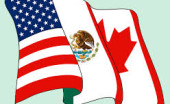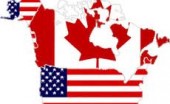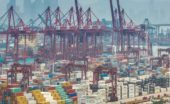Johannah Bernstein post: "eternally proud of my father’s extraordinary aeronautical engineering. legacy. here is a photo of the Canadair Water…
Wednesday Night #1279
Written by Diana Thebaud Nicholson // September 6, 2006 // Canada, Climate Change, Economy, Oil & gas, Politics, Reports, Wednesday Nights // Comments Off on Wednesday Night #1279
The Report
The world economy
As year-end approaches, there are increasing concerns about the economy with cracks becoming evident in the U.S. housing market where homes may be bought without down payment, where it has been estimated that forty percent of all mortgages will not be able to be sustained because of increasing interest rates and borrowing on equity.
The exceptions are Florida, California, New Jersey and New York where high speculation, especially by pension funds, have maintained the real estate market.The results of the housing market and weather have yet to be realistically assessed in Florida where the memory of Katrina remains fresh, resulting in a fifty percent increase in insurance rates and fixing limits on compensation for damage.
The face of world trade continues to change. While there is some hint of forthcoming problems in the U.S. and Europe, there is less upward pressure on the Canadian dollar which has been, in large part, maintained through mergers and takeovers.
Japan is continuing to do well and may be headed towards the establishment of a third free trade area including other Asian countries, Australia and New Zealand.
It is possible that at some point in the future, there will be only three world currencies, namely the U.S. dollar, the Euro and a future Asian block currency.
A recession is not foreseen, especially if interest rates do not rise at this time.
Free Trade Areas
While free trade areas have generally been beneficial to all participating countries, there has been some concern expressed that this has been offset by the loss of workers’ rights and the unconscionable deterioration of the environment. NAFTA has been generally regarded positively, with Canada having benefited more than have our American partners, with the softwood lumber dispute an exception, as that issue had never been resolved during free trade negotiations.
Mexico
There are times when NAFTA has the appearance of an anomaly. Mexico’s Felipe Calderón, a free-trader has been elected President, succeeding Vicente Fox, but the loser, Manuel López Obrador has contested the election and aims to set up a parallel government. Imagine if Al Gore had set up a parallel government after losing the election to George W, or Paul Martin had done the same in Canada! Why does this great divergence in political culture exist? One explanation offered is that the people in the U.S. and Canada are generally not willing to admit the failures of democratic institutions, whereas such failures are a given in Mexico.
Nonetheless, as disparate as the three participants in the NAFTA agreement appear, it is generally believed to have been beneficial to all.
Knowledge banks versus data distribution banks
Large institutions frequently style themselves ‘data banks’ and indeed they are good at collecting all forms of information from varied sources. What they are not very good at is distribution of the accumulated information in useful form. Information often goes to the end user in the form of massive, expensive hard copy reports (which are virtually unintelligible) or spreadsheets that require extensive analysis. The solution is for the institution to conduct the analysis, based on data collected from the clients and then allow the client organizations to ask the questions relevant to their particular situation. While there is a danger that this process does not encourage developing nations to increase their analytical expertise, it is far preferable to the current unsatisfactory and inefficient situation.
Oil
Partly due to environmental conditions, especially the relatively mild hurricane season, the price of petroleum has decreased and will probably decline further. The recently discovered oil find in the Gulf of Mexico, while theoretically representing fifty percent of U.S. oil reserves, lies 8.2 to 8.4 kilometres below the surface, making the prospect of recovering it very problematic.
The federal Liberal leadership race
As the Liberal leadership convention approaches, the race appears to have narrowed down to three likely candidates and the winner expected to be the one who comes to the race with the least personal baggage. Stéphane Dion, a bright, eloquent, bilingual Quebecker, has yet to overcome his unpopularity in his home province and may be viewed as too close to Paul Martin, Bob Rae carries the baggage of an unfavourable reputation in running the financial end of Ontario when Premier of that province, but in the view of some observers is the best person to rebuild the battered Liberal Party. A tight race is forecast between him and Michael Ignatieff, the latter having to convince the electorate that he is back in Canada to stay, and needing to acquire the ability to distinguish between truth and propriety in his public statements.
Ignatieff has just issued a Manifesto “Agenda for nation building” which, aside from the obvious, focuses on prosperity, Canada’s place in the world. He favours Canada’s role in Afghanistan, believing in peacemaking over peacekeeping.
Elections this year?
Unlikely in Québec. The Charest Liberals simply aren’t popular enough. At the federal level, despite their lack of a leader , the Liberals are nipping at the heels of the Conservatives. The Conservatives will want to avoid an election until they can make peace with the provinces and bring in a new budget – not before next year. Meanwhile, Harper is applying the same tactic as the Martin minority government: make sure that any blame for calling an unpopular election would fall on opposition parties.
Kyoto, Conservatives and California
As for Stephen Harper, his continued importation of U.S. policy into Canada, particularly on the Kyoto accord, will not win him increased popularity, especially in Québec. Watch for the mid-October interministerial meeting (Oct 12-14) in Yellowknife of federal, provincial and territorial ministers responsible for environment, parks, forestry, fisheries and sustainable development. It is expected that the federal government may by backing off involvement climate change issues, latch onto the less controversial issues related to Biodiversity strategy. [Editor’s note: The federal Conservatives are cancelling a $1.5 million pledge by the previous Liberal government to help developing countries cut greenhouse emissions under the rules of the Kyoto Protocol – one more nail in the coffin of Canadian leadership on climate change issues]
To the Kyoto naysayers, it is suggested that rather than looking at U.S. federal policy, look to California as a model. It has endorsed emissions controls and has proven that adherence to the principles of Kyoto does not mean economic disaster. It was done and changed the aspect of the entire world. Why can’t Canada do the same? The Chinese will do what is necessary because it would cost too much not to and in the view of some Wednesday Nighters (and the London Free Press), Harper is barking up the wrong tree. California, twenty-nine other states and many major cities such as Chicago will adhere to Kyoto even though they are not signatories. It is also interesting to note the lead that is being taken by business in the U.S. and internationally, with giants like GE, Walmart and Fedex showing the way.
Invasion of corporate communications
Piracy has returned to the ether waves. Cybernetic pirates connected to organized crime, mostly Eastern Europeans, have succeeded in bypassing firewalls by overloading them simultaneously with sufficient identical instructions to ensure that some get through and switch control of the targeted computers to the pirates, who initially use them to recruit and control other computers and then demand ransom in one form or another to return control to their legitimate owner. To date, there is no defence against this form of invasion.
QUOTES of the EVENING
Since Pluto has been downgraded, a lot of things have been going wrong, so we should be very careful about prognostication
Softwood lumber was never resolved during free trade negotiations. There are winners (the powerful) and in the short term, the losers (the weak)
We have benefited enormously from the Free trade agreement … Euro zone has also benefited greatly. Japan in agreement with Australia, New Zealand and other Asian governments … We will ultimately end up with a small number of currencies, possibly the Euro, the U.S. dollar and an Asian currency
Are the Taliban actually bad guys? Is this an idealogical rather than tribal dispute … different groups controlling different territory? Why are we there?
Layton is pandering to some sector of the population that is not there Harper will not call an election but will probably wait for the opposition to force one
My feeling is that Harper will make his concession (to the provinces) in the budget (Spring 2007) and will call an election if his prospects look good
Buttonwood on the outlook for financial markets over the next 12 months
(The Economist of September 5)
The outlook for financial markets over the next 12 months depends on the answers to two questions. First, what does it mean for the American economy that short rates are above long bond yields-that, in the jargon, the yield curve is inverted? Second, can companies continue to earn today’s high level of profits as a share of GDP?
Take the optimistic view and you can construct a bullish case for equities. The yield curve is not a signal of impending recession, simply a reflection of greater confidence in the ability of central banks to control inflation. And with the balance of power in the global economy having shifted from workers to employers, there is no need for corporate profits to come under pressure.
The pessimistic view is that the yield curve does indeed signal economic troubles as it has in the past-and at a time when profits are already cyclically high. If so, profits and share prices could be in for a double blow as the economy slows and margins come under pressure.
Buttonwood is a great believer in reversion to the mean. Because the optimistic school implicitly argues that “things are different this time”, it is tempting to side automatically with the pessimists.
But the facts are a little more complex. The standard assumption in finance textbooks has been that long-term rates should be above short rates because borrowers must pay a premium for illiquidity, just as UK building societies pay higher rates to savers willing to lock away their money for 90 days.
An upward-sloping yield curve has come to be perceived as “normal”. Hence the use of the term “inverted” to describe the situation today.
But as Andrew Smithers, of the economic consultancy Smithers & Co, points out, in the 19th century an inverted yield curve was the norm. It was only in the 20th century, when inflation unexpectedly surged, that the curve became upward sloping. Bond investors demanded a premium for the risk that inflation would erode the real value of their holdings. Now that inflation has receded, perhaps this premium can disappear.
Another way to think about this is to remember that volatile assets should carry a risk premium. Over the short term (less than 12 months), bonds are usually more volatile than cash. But over a period of several years, this may not be so, since short rates are adjusted frequently by central banks in an attempt to damp the economic cycle and keep long-run inflation stable. Investors, such as pension funds, with a long-term horizon, have no need for bonds to offer a risk premium. Indeed, in Britain, because of actuarial theory and accounting regulations, the very longest-dated government bonds are much sought after and offer lower yields than cash or short-term bonds.
A flat, or inverted, yield curve could well become much more common than in the past 50 years. Even the recent direction of bond yields does not necessarily provide support for the pessimists. Ten-year Treasury bond yields have dropped from 5.24% in June to 4.74% this week. But if that is because investors are nervous about global growth, then it is hard to explain why emerging markets have rebounded so strongly from their June lows or why commodity prices are just 6% below the year’s high.
The case for profits to revert to the mean looks rather clearer. After all, in both the United States and Britain, profits are at a 40-year high as a share of GDP. Figures from UBS show that corporate profits are taking their biggest bite of GDP in the G7 countries in the past quarter of a century.
Optimists say that globalization has changed the rules. The entry of China, India and the ex-Soviet block into the global economy has, in effect, doubled the labour force. That has enabled companies to expand without meeting one of the normal constraints of the economic cycle: rising wages. In the early part of this decade, lower interest rates also slashed debt costs.
Neither the increases in commodity prices nor the recent tightening of monetary policy seems to have made much of a dent in this: profits in America and Europe are still rising at double-digit percentage rates.
But how long can this trend continue? Theory would suggest that, even if the odds have shifted in favour of capital, balancing factors should come into play. If returns on capital are high, more companies will be created and existing companies will invest more money. The resulting competition should drive down returns. Only if new businesses face barriers to entry could high returns be sustained. That is unlikely given how competition seems even more intense in a globalised world.
However, reversion to the mean could take years and, in the interim, investors will not be too concerned if companies are returning cash by the fistful in the form of buy-backs, higher dividends and takeover deals.
People typically see corporate cash flow as a strong support for the market and James Montier of Dresdner Kleinwort says that buy-backs could add three percentage points to the American dividend yield in 2006.
However, today’s high level of buy-backs may indicate that companies are aware their earnings strength is temporary. Managers are reluctant to increase dividends in the face of a transient boost to profits, lest they have to cut their payments in later years-a signal that is taken badly by the markets.
Mr Montier finds a close correlation between net repurchases of equity in the American market and the deviation of earnings from their trend value. Both are at their highest level in the past 20 years.
So perhaps investors should not read too much into the inverted yield curve. On the other hand, they should be concerned about profits, which look unsustainably high. With the Conference Board’s measure of chief-executive confidence showing a recent decline, it looks as though companies are starting to fear that the best years of this cycle are behind them.



